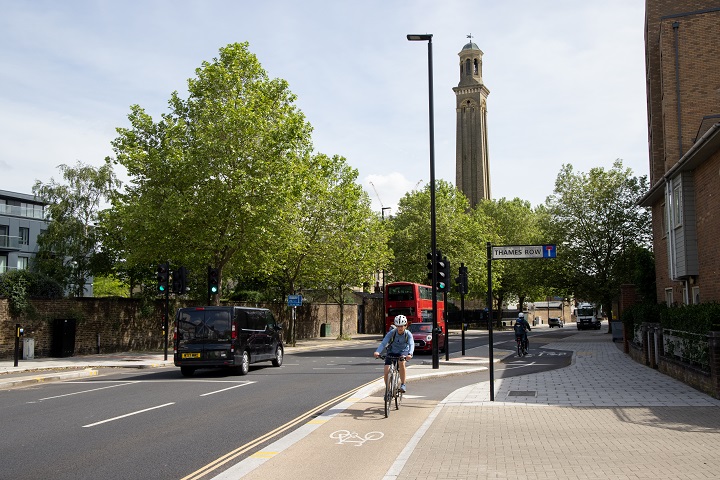
A street scene on Kew Bridge Road.
More than 50km of new cycle routes and 400 pedestrian crossings have been introduced in London in the past year, as part of continued efforts to reduce road danger, improve air quality, and encourage active travel.
Under TfL’s Local Implementation Plan, £80.85m in funding was spent between April 2024 and April 2025 on borough-led projects designed to make the capital safer, healthier and more sustainable.
Highlights have included:
- Schemes to boost walking: More than 400 new pedestrian crossings have been installed with 61 new signal-controlled crossings, 108 zebra crossings and 232 uncontrolled crossings. 12km footways have also been widened to make it easier to walk
- Schemes to make it easier and safer to cycle: 51km of new permanent cycle routes have been constructed. TfL and boroughs have also worked to deliver cycle parking, with 1,673 publicly accessible cycle parking spaces created, plus 10,000 residential and 900 school cycle parking spaces. Funding has also enabled 16,631 adults and 51,190 children to be trained with vital cycling skills
- More School Streets: 150 more School Streets have been introduced, with the total now standing at more than 800 across London
- Improved public transport access: 64 bus stops have been given accessibility upgrades, and 2.8km of new bus lanes to improve journey times and reliability
- More low-traffic neighbourhoods: Seven new schemes to reduce traffic on local roads were introduced, 15 experimental schemes were made permanent, and 26 new road closures have been implemented to reduce through-traffic and improve local air quality
TfL says these improvements are helping to reduce traffic, improve road safety and enable more Londoners to choose walking and cycling for everyday journeys. Boroughs bring deep local knowledge of their communities and transport networks to these projects, ensuring they meet the needs of their residents, it adds.
TfL will continue partnering with London’s boroughs to improve road safety across the capital throughout the three-year programme. Boroughs have set out plans to help deliver 222 new School Streets schemes and up to 95km of new cycle routes by 2027/28.
The programme will also aim to deliver further projects to tackle road danger across London, including 15 new schemes at some of London’s most dangerous junctions and new borough-wide 20mph schemes.
Boroughs will play a key role in delivering TfL’s next Vision Zero Action Plan, which is due to be published early next year.
Helen Cansick, TfL’s head of healthy streets investment, said: “London’s boroughs play a crucial role in delivering improvements that make our streets safer, more accessible and more sustainable.
“The level of ambition from passionate borough officers has increased year on year, as they see the value that this investment has for the communities they serve – from safer places to cross the road and expanded cycle routes to lower traffic speeds, safer journeys for schoolchildren and cleaner air.
“We look forward to continuing working with boroughs to build a better, safer and greener London for everyone.”
Will Norman, London’s walking and cycling commissioner, said: “This impressive data highlights the power of working in partnership, with TfL’s expertise and London boroughs’ deep local knowledge combining to create streets that truly reflect the needs of their communities.
“This ongoing work to make it easier and safer for Londoners to choose walking or cycling for shorter journeys is vital in achieving the Mayor’s Vision Zero target and building a healthier, more sustainable city for all.”
What happens when boroughs don’t play ball ? Looking at the London Borough of Killing Cyclists. You can’t build a healthier city if there are big gaps in the middle of the network.
Paul Luton, Teddington
0